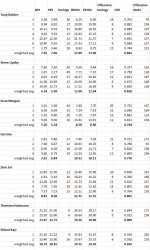2/5MR2
amateur
For those interested in the analytical aspect of 14.1:
I have been scoring matches of the Amsterdam Billiards 14.1 league for a while now, so much that I have enough data now to compare various 14.1 metrics. For some players (mostly open/pro-level players) I have multiple matches. I have also scored the final and semi-finals of last year's American 14.1 championship as I was watching them so I also have some data for the very top players.
Here is what I think the data shows:
BPI, PPI: The values doesn't appears correlated with anything we could care about. The same player sometimes have 2.00 for one match and 14.00 for the other match. Over multiple matches, the weighted average (by innings) fails to rank the players in the order you would put them if you are familiar with their skill level.
BPASI, PPASI: Doing much better than than BPI and PPI but again, values vary wildly in size for the same player (6.00 to 21.57), (7.35 to 24.00). The weighted average (by offensive innings) roughly ranks the player in the order you would put them.
OPI: This is the metric I am proposing to measure a player -offensive- performance during a match. Just like BPASI, PPASI it measures only the offensive aspect of the game. The major difference is that the averaging is over offensive shots (instead of over offensive innings). I find the result from this very small set of data to be very encouraging. For the same player, values are very consistent, the weighted average over all matches (weighted by the number of offensive shots) does rank the players in the correct order. Also, since the values are so consistent, the OPI value for just 1 match does say something about the absolute skill level of the player. Some time ago I came up with these rough categories after scoring the first few matches with OPI calculated. I have way more data now but these categories have held up:
0.000 to 0.200: Beginner
0.200 to 0.500: Amateur
0.500 to 0.750: Good amateur
0.750 to 0.900: Pro
0.900 to 1.000: Top pro
Even for amateurs players: players in the 'Gold' division score in the 'Good amateur' category almost always, and people in the 'Silver' division in the Amateur category (very little data in this case but still).
If you want to know more about how OPI is calculated, I have started to work on a webpage with the details:
http://www.metaobjects.ca/foe/opi.html
Would love to hear what people interested in that kind of analytical stuff think. All 3 or you.
I have been scoring matches of the Amsterdam Billiards 14.1 league for a while now, so much that I have enough data now to compare various 14.1 metrics. For some players (mostly open/pro-level players) I have multiple matches. I have also scored the final and semi-finals of last year's American 14.1 championship as I was watching them so I also have some data for the very top players.
Here is what I think the data shows:
BPI, PPI: The values doesn't appears correlated with anything we could care about. The same player sometimes have 2.00 for one match and 14.00 for the other match. Over multiple matches, the weighted average (by innings) fails to rank the players in the order you would put them if you are familiar with their skill level.
BPASI, PPASI: Doing much better than than BPI and PPI but again, values vary wildly in size for the same player (6.00 to 21.57), (7.35 to 24.00). The weighted average (by offensive innings) roughly ranks the player in the order you would put them.
OPI: This is the metric I am proposing to measure a player -offensive- performance during a match. Just like BPASI, PPASI it measures only the offensive aspect of the game. The major difference is that the averaging is over offensive shots (instead of over offensive innings). I find the result from this very small set of data to be very encouraging. For the same player, values are very consistent, the weighted average over all matches (weighted by the number of offensive shots) does rank the players in the correct order. Also, since the values are so consistent, the OPI value for just 1 match does say something about the absolute skill level of the player. Some time ago I came up with these rough categories after scoring the first few matches with OPI calculated. I have way more data now but these categories have held up:
0.000 to 0.200: Beginner
0.200 to 0.500: Amateur
0.500 to 0.750: Good amateur
0.750 to 0.900: Pro
0.900 to 1.000: Top pro
Even for amateurs players: players in the 'Gold' division score in the 'Good amateur' category almost always, and people in the 'Silver' division in the Amateur category (very little data in this case but still).
If you want to know more about how OPI is calculated, I have started to work on a webpage with the details:
http://www.metaobjects.ca/foe/opi.html
Would love to hear what people interested in that kind of analytical stuff think. All 3 or you.
